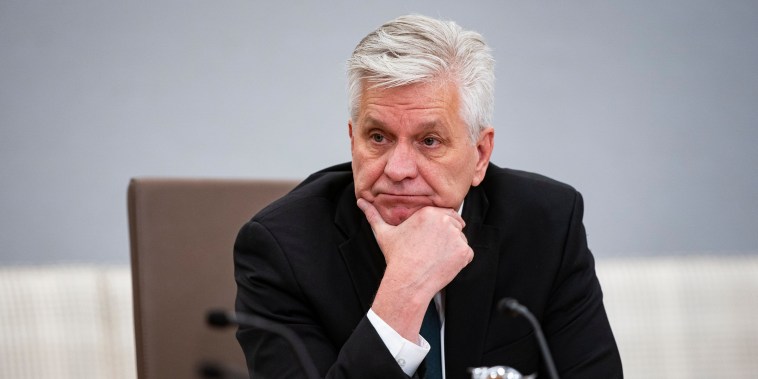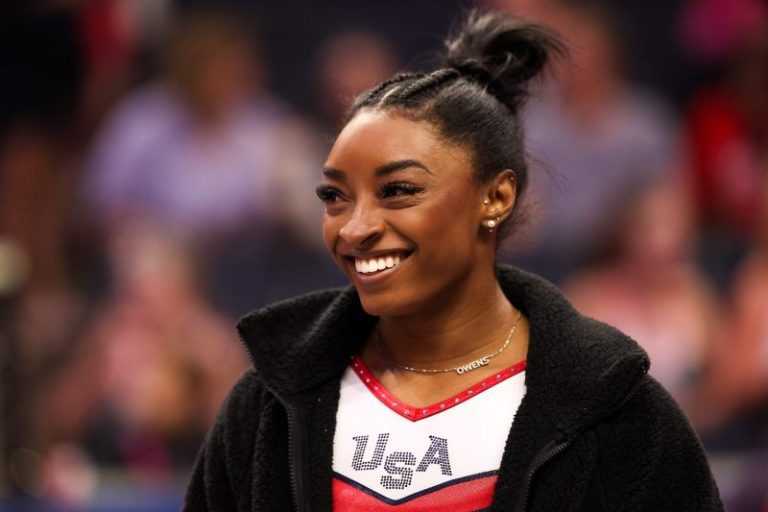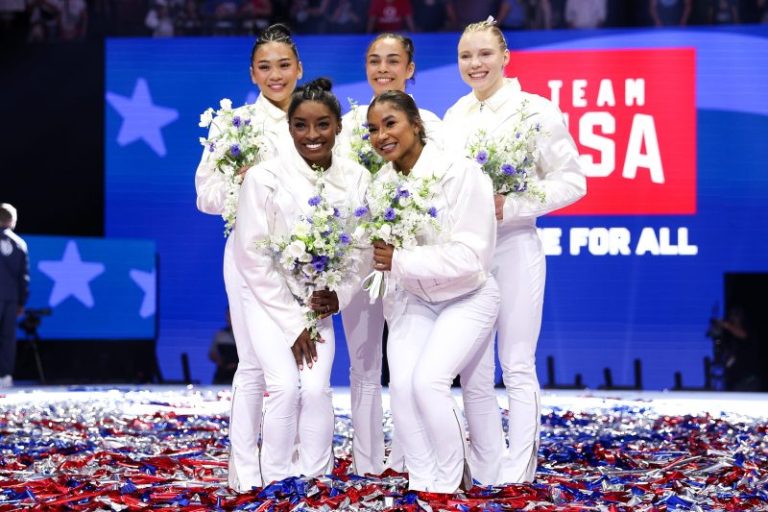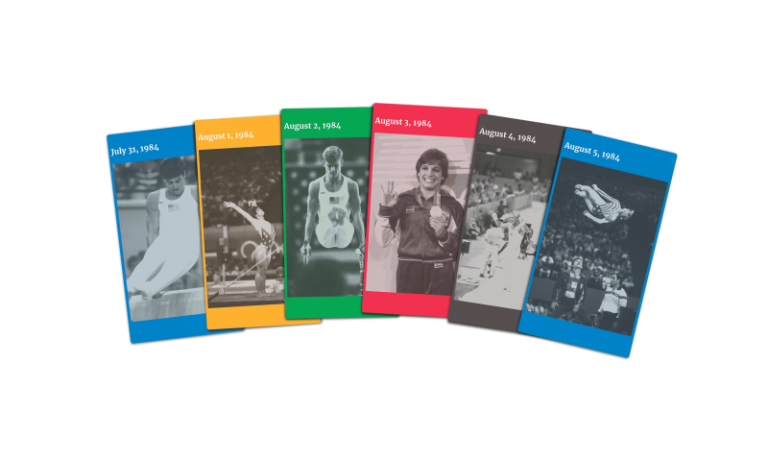For much of its first 19 years, Pauley Pavilion was best known as a place where history was made on hardwood. But for one week in the summer of 1984, the floor of UCLA’s storied sports arena was transformed into a brilliant cacophony of mats, bars and beams.
Like John Wooden, Kareem Abdul-Jabbar and Bill Walton before them, it was at this venue that the 12 gymnasts representing the U.S. at the Summer Games in Los Angeles left an indelible mark on their sport.
Over the course of six nights, the U.S. men’s and women’s Olympic gymnastics teams flipped, tumbled and vaulted their way to Olympic glory. They captivated sold-out crowds on their way to collecting a total of 26 medals — 10 of them gold — announcing American gymnastics’ arrival on the world stage.
Unable to view our graphics? Click here to see them.
Night one: men’s team all-around
July 31, 1984
When the U.S. men’s gymnastics team entered Pauley Pavilion for the first time on the evening of the team all-around final, it did so through a small tunnel that connected the venue to a warm-up gym a few hundred yards away.
In that tunnel, away from the gaze of the thousands in attendance, the athletes huddled for one final time before taking the floor. The nerves had settled in. Outwardly, they shared high-fives and encouragement but inside, they had their doubts.
“We had no dream of getting a gold medal,” said Bart Conner. “We thought China was so good, I [didn’t] know if there was any way we could do that.”
Sensing the unease that pervaded his group, coach Abie Grossfeld decided it was time to deliver a unique pep talk.“He called us over at one moment, right before we got out there,” recalled Mitch Gaylord. “And he goes, ‘Hey guys, I just want you to remember, there’s nothing to be nervous about here. There’s only 2.2 billion people watching you around the world right now.’ ”
It was the perfect way to break the ice.
“We all just started cracking up,” Gaylord said. “We were like, ‘Whatever. Let’s just go out there and have some fun.’ And that’s what we did.”
By the time Peter Vidmar stepped up to the high bar as the final U.S. performer on the last of the six apparatus rotations, the Americans had already broken the first-place deadlock with the Chinese and secured their spot atop the medal podium.
“There was a sense of surrealness, if that’s a word,” Conner said. “You always think, ‘Oh, wouldn’t it be cool?’ And then all of a sudden we’re standing up there and they’re playing the national anthem and they’re putting a medal around our necks. It’s mind-boggling.”
Night two: women’s team all-around
Aug. 1, 1984
Sitting in a cramped UCLA dorm room in the nearby Olympic village, the U.S. women’s gymnastics team had its eyes glued to the television screen.
A few minutes’ walk from Pauley Pavilion, the gymnasts watched the live broadcast of the men’s team all-around competition, and they celebrated — jumping and dancing around the room.
“It was so exhilarating,” said Michelle Dusserre Farrell, a member of the 1984 U.S. women’s gymnastics team.
But soon, elation turned to nervousness as they realized the magnitude of the task ahead. “We knew the spotlight was going to turn onto us the very next day,” she said. “We knew it was going to be inevitable that we would have that same expectation.”
But as the tension mounted on the night before the women’s team all-around competition, levity came from an unexpected source.
Inspecting their now iconic star-spangled leotards for the first time, the women initially laughed at how ridiculous they believed they would look in them. But those feelings changed once they tried them on.
“This [was] the most comfortable leotard I’d ever worn,” Kathy Johnson Clarke said. “It felt like a second skin.”
With their snug new uniforms and the home crowd cheering, the U.S. was the top scorer in two of the four team events. But despite Julianne McNamara’s perfect 10 on the floor and uneven bars, and Mary Lou Retton finishing with the highest individual score, the Romanians proved too much to overcome, securing first place in the team all-around by a single point.
Still, the 1984 team became only the second American women’s team to medal in the team all-around, and the first to win silver.
Night three: men’s individual all-around
Aug. 2, 1984
Vidmar was at home in Pauley Pavilion. By the summer of 1984, the Los Angeles native and five-time NCAA champion had spent several years competing in that arena during a prolific gymnastics career at UCLA.
Alongside fellow Bruins Gaylord and Tim Daggett, Vidmar’s Olympic experience was the culmination of a long, arduous journey that started in Southern California.
“It’s a lifetime of effort and work,” Vidmar told the Resilience to Brilliance Podcast in January. “I lived in the gym with these guys (Gaylord and Daggett). There were so many days where it was really hard … not fun and that’s when I think you learn the most about yourself.’
Coached from a young age by a former U.S. Olympian, Makoto Sakamoto — who later served as Vidmar’s assistant coach at UCLA and on the 1984 Olympic team — Vidmar was constantly taught to test the limits of what he believed he could accomplish in the gym.
“I tried to lead by example,” said Sakamoto, who was in his mid-30s when he coached Vidmar at UCLA.
It was a common occurrence at training sessions in those days for him to challenge his athletes to a friendly competition of handstand push-ups on the parallel bars.
“I’d say to the guys, ‘Hey, see if you can beat me,’ at the end of practice. A really hard practice,” Sakamoto recalled. “I never lost to them, (but) they really tried.’
Steeled by his work ethic and the fierce competitors who surrounded him in Westwood, Vidmar’s triumphant swan song at his old college gym included a silver medal in the individual all-around competition, when he became the first American man to medal in that event.
Night four: women’s individual all-around
Aug. 3, 1984
For the first time in days, Pauley Pavilion was dead quiet. The gravity of the moment had settled in for the 9,023 spectators.
After a back-and-forth women’s individual all-around competition, in which Romania’s Ecaterina Szabo held a slight lead entering the final rotation, Mary Lou Retton would need to score a 9.95 on the vault in order to secure the gold medal, and a perfect 10 to win it outright.
In an instant, the cheers halted and the chatter subsided. The weight of an entire country fell on the strong shoulders of one diminutive teenager.
“I hope she has her wings on today for this vault,” said analyst Cathy Rigby McCoy on the ABC broadcast as Retton readied her approach.
For Retton, getting airborne was the easy part. What she struggled with, according to Johnson Clarke, was sticking the landing.
“You’ve got to be able to be that high, that explosive, and somehow come to a complete stop and then not move your feet and hold a position for a stick. Mary Lou never did that,” Johnson Clarke said with a laugh.
But when it mattered most, Retton left no doubt.
“Oh my gosh, did she find that landing,” Johnson Clarke said. “I wanted to genuflect. Talk about the stars aligning so perfectly. For that final star to just land right in place, in that moment when she needed a 10 to win. There it was.”
In a matter of seconds, Retton launched herself from relative obscurity to Olympic superstardom. Bela Karolyi, her coach, knew it instantly.
“That’s a 10!” Karolyi shouted over and over again as the arena exploded with applause. So boundless was his excitement, it didn’t even matter that he didn’t have a place to stay that night.
When Bob Condron, then the director of media services and operations for the U.S. Olympic Committee, went to pick up Retton and Karolyi for a television appearance the next morning, they found the boisterous coach wrapped in a quilt behind Pauley Pavilion.
“He was sleeping in an alley,” Condron said. “We basically woke him up and grabbed him.”
Night five: men’s apparatus finals
Aug. 4, 1984
Four days after their historic gold medal victory in the team event, the U.S. men’s team returned to Pauley Pavilion for one final time.
With six events and at least 18 medals up for grabs, the Americans took home six to put an exclamation point on their odds-defying Olympic run.
“For me, it was perfect timing,” Gaylord said. “I’m from Los Angeles, it was the L.A. Games. I went to UCLA, gymnastics was in Pauley Pavilion. Everything kind of lined up for success and that felt incredible to me. We were here to do something really, really special.”
Gaylord’s team-high three podium finishes that Saturday — a silver and two bronze — cemented his place as one of the most decorated U.S. gymnasts of all time. Vidmar’s gold medal on the pommel horse and Conner’s gold on the parallel bars only added to the legend that was the 1984 squad.
“There’s a brotherhood there,” Conner said. “When we see each other, we hug each other in a different way because there’s no way any of us would have been standing up there individually if it weren’t for those other guys on the team.’
That bond, first forged in the fires of NCAA competition and then shaped into a lasting friendship on the Olympic stage, played a critical role in allowing this group to reach heights previously unforeseen in U.S. men’s gymnastics.
“What they did was make a conscious decision,” Johnson Clarke said. “They left their egos outside the door every time they walked into this gym to train together, to compete together, to perform to their fullest together.”
Night six: women’s apparatus finals
Aug. 5, 1984
On the sixth and final night at Pauley Pavilion, in a week that had turned this basketball mecca into a medal mine for U.S. gymnastics, the women’s team took to the mat for a chance at individual glory.
For Johnson Clarke, 24, this was a long-awaited curtain call on an unconventional-yet-storied gymnastics career that began at 12.
“Everything was not lined up perfectly for me to be at the Olympic Games,” she said. “Nothing was actually ideal, but in a way it was perfect. It was perfect for me because it grew my heart. It grew everything that’s important to me and what makes me love this sport.”
Johnson Clarke’s bronze on the balance beam ensured that at least one American woman medaled in all four events that evening. McNamara’s silver on the floor exercise and gold on the uneven bars set the pace, while Retton added three podium finishes to her already transcendent performance.
With 13 medals to their names, the “Silver Sisters” — as they still call themselves — left the ‘84 games with close friendships that would last far into the future. At the center of it all was Johnson Clarke, captain and “team mom.”
“I was able to follow (Kathy’s) lead in many ways,” said Dusserre Farrell, the youngest member of the 1984 team. “To sort of lean on her experiences, her support, her leadership, her ability to handle a lot of the stress and the pressure. We were all kind of in it together, so we leaned on each other a lot.”
After nearly quitting the sport altogether five years earlier, Johnson Clarke fully embraced her maternal role. Even now, she said, the love and respect each of the women share for one another is just as strong as it was in 1984.
“The relationship that we started even years before we ever shared that moment in history together is what makes it so deep and so rich,” Johnson Clarke said. “And then the life after in these subsequent 40 years that we have been there for each other, we’ve had each other’s backs.”
This post appeared first on USA TODAY










